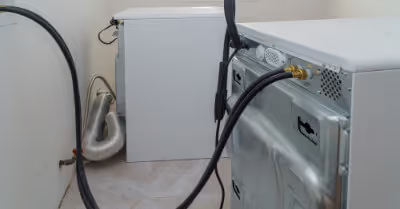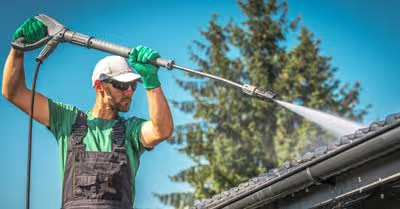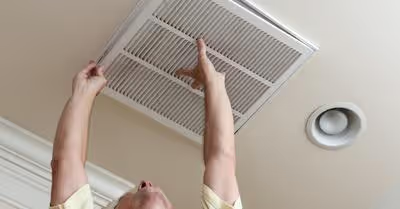Table of Contents
Types of Water-Shutoff Valves
There are some different types of valves that you should be aware of before you start working on your water-shut off leak.
Compression Fit Valves
Compression fit valves are used for PEX or copper water lines. The line will have a compression nut with a copper compression sleeve over it. A compression nut will tighten it over the stop valve.
There are two types of compression fit valves:
- Multi-turn valves - this type takes several turns to completely turn the water flow off. They are cheaper, but can be prone to leaks. Multi-turn valves use a gate to control the flow of water.
- Quarter-turn - these tend to be higher quality than multi-turn valves and use a positive action ball valve. A quarter-turn on the valve will shut off the flow of water. This is the recommended type if you are replacing a water-shutoff valve anyway. Quarter-turn valves use a ball to control the flow of water.
Sweat Fitting Valves
A sweat fitting valve has to be soldered onto a copper pipe.You won’t be able to easily remove it, but it makes a tight connection that is leak proof. Sweat fitting valves do not have any hex flats where the copper pipes into the wall.
FIP Threaded Fitting Valve
These are female iron pipe, or FIP, shut off valves that you can use with galvanized steel supply lines. You will have to use pipe thread compound, but they are easy to install because they just screw.
Push Fit Valve
This type of valve is easy to install and you can use them for copper, PEX, or CPVC lines. You also don’t need any tools to install them. The supply just needs a square vut and you push it on. Just make sure to test the water to make sure there are no leaks and you will be good to go.
Tighten Packing Nut
A packing nut should prevent leaks, but that isn’t always the case. The packing nut is the nut that surrounds the stem and connection. On new water-shutoff valves, simply tightening the packing nut often fixes a small leak.
Use a wrench to tighten the packing nut up to a quarter turn. Test to check if it is still leaking. If it is, you may need to replace the packing washer.
Replace Packing Material
The packing nut on the shutoff valve will tighten packing material against the washer to prevent leaks. Sometimes, this material will decay and be ineffective. The first step will be to remove the handle. It usually will just unscrew by hand. Be sure to shut off any water flowing to the water valve you need to repair. For this fix, you need to remove the handle. Usually you can unscrew it by hand.
Now, you can use a wrench to unscrew and remove the packing nut. Simply remove the old washer and replace it with a new one. There may be other material, such as Teflon, that needs to be replaced as well. Sometimes a washer replacement is sufficient, but sometimes you will need to wrap packing material around the stem three times to make a leak proof connection. Replace the pieces, but do not over tighten. Turn the water on. If it still leaks, try tightening the packing nut one more time.
Replace Water-Shutoff Valve: Removing the Old Valve
The first step (after turning off the water and running it out of the faucets!) is to remove the old water-shutoff valve. The removal is different for different types of valves.
Compression Valve
To take an old compression valve off, hold the body with one wrench while you use another to loosen the nut. When it is loose enough, the valve will slide off of the tubing. Now you will have to remove the old sleeve.
Use pliers to grab the sleeve. Do not grab too tightly because you don’t want to alter the shape of the copper tubing. Rotate and pull to remove it. If it is stuck on too tightly, you will have to saw it to snap it off.
To saw and remove it, use a hacksaw to cut into the sleeve. Cut into it with an angle and avoid cutting into the tubing. Then, place the end of a flat head screwdriver into the cut you made. Twist it to slowly break the sleeve apart and slide it off.
Sweat Valve
This will require a soldering torch to remove. If you do not know anything about soldering, it is best to seek the help of a professional. Always have a fire extinguisher ready in case of emergency. Use flame protection cloth to guard any nearby walls from fire.
Use a wrench or pliers to hold the sweat valve while you loosen the packing nut. Unscrew the valve stem. Then, you need to remove the old washer. They are often stuck down.
Your flame should be small. Aim it towards the body of the valve. Ease it towards the body and as soon as the solder starts to melt, twist and pull the valve away from the tubing with pliers or a wrench.
Now you will have to remove any and all soldering. It is best to use emery cloth. If you are replacing it with a new sweat valve, you just need to take off enough soldering to slide it on. Then you can put flux on the valve and tubing. Solder it on and wipe any excess solder away.
If you are going to install a compression valve, make sure to sand away all remaining solder first.
Replace Water-Shutoff Valve: Installing the New Valve
If you are replacing a water-shutoff valve, you should use either a quarter-turn compression valve or a push fit valve.
Compression Valve
The first thing you need to do is accurately position the new valve. Slide the escutcheon and compression nut onto the tubing. Now you will slide on the compression sleeve. Make sure to place it slightly forward of old marks left by the old compression sleeve.
Now, apply a thin coat of pipe dope to the sleeve and screw put the valve on. Now you will screw the compression nut on. Hold the valve steady with a wrench and tighten the nut according to the manufacturer’s instructions. Connect the supply.
Push Fit Valve
Push fit valves can be installed without tools which makes them a good choice as long as you have enough tubing coming out of the wall. You can sometimes even use them to replace a compression valve or sweat valve. The tubing needs to be symmetrical and have a square end.
There will also need to be at least an inch of stub-out tubing. It is best to measure your tubing first. Then you can check the manufacturer’s length requirement to find one that will work.
If you are using a push fit valve to replace a sweat valve, make sure you remove all solder first. The tubing needs to be perfectly round for the push fit valve to attach correctly.
To install, just push the valve onto tubing until it is all the way on. Then, as with any plumbing project, double check to make sure there is no leak.
Recent Articles
















